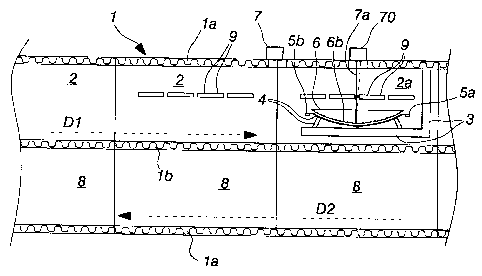Some of the information on this Web page has been provided by external sources. The Government of Canada is not responsible for the accuracy, reliability or currency of the information supplied by external sources. Users wishing to rely upon this information should consult directly with the source of the information. Content provided by external sources is not subject to official languages, privacy and accessibility requirements.
Any discrepancies in the text and image of the Claims and Abstract are due to differing posting times. Text of the Claims and Abstract are posted:
| (12) Patent Application: | (11) CA 2573608 |
|---|---|
| (54) English Title: | METHOD FOR MEASURING THE SAGGING OF A GLASS PANEL |
| (54) French Title: | PROCEDE PERMETTANT DE MESURER L'AFFAISSEMENT D'UNE PLAQUE DE VERRE |
| Status: | Deemed Abandoned and Beyond the Period of Reinstatement - Pending Response to Notice of Disregarded Communication |
| (51) International Patent Classification (IPC): |
|
|---|---|
| (72) Inventors : |
|
| (73) Owners : |
|
| (71) Applicants : |
|
| (74) Agent: | SMART & BIGGAR LP |
| (74) Associate agent: | |
| (45) Issued: | |
| (86) PCT Filing Date: | 2005-06-30 |
| (87) Open to Public Inspection: | 2006-01-19 |
| Availability of licence: | N/A |
| Dedicated to the Public: | N/A |
| (25) Language of filing: | English |
| Patent Cooperation Treaty (PCT): | Yes |
|---|---|
| (86) PCT Filing Number: | PCT/FI2005/050261 |
| (87) International Publication Number: | WO 2006005805 |
| (85) National Entry: | 2007-01-11 |
| (30) Application Priority Data: | ||||||
|---|---|---|---|---|---|---|
|
The present invention relates to a method for measuring the sagging of a glass
panel (6) in the process of bending the glass panel (6) on a ring mould (4).
The method comprises measuring the sagging at a glass panel's measuring point
and the measurement data is applied to control progress of the bending
process, especially heating of the glass panel (6) or abortion of the bending
process. A reference plane (5a, 5b) stationary with respect to the ring mould
(4) is established, a distance gauge (7, 70) is used for measuring a distance
between the reference plane (5a, 5b) and the distance gauge (7, 70), a
distance gauge (7, 70) is used for measuring a distance between the glass
panel's (6) measuring point and the distance gauge (7, 70). The glass panel's
(6) sagging is determined by comparing the distance between the reference
plane (5a, 5b) and the distance gauge (7, 70) to the distance between the
glass panel's (6) measuring point and the distance gauge (7, 70).
L'invention concerne un procédé permettant de mesurer l'affaissement d'une plaque de verre (6) dans le processus de cintrage de la plaque de verre (6) sur un moule en couronne (4). Le procédé consiste à mesurer l'affaissement au niveau d'un point de mesurage d'une plaque de verre et à utiliser les données de mesurage afin de réguler l'avancement du processus de cintrage, notamment le chauffage de la plaque de verre (6) ou l'interruption du processus de cintrage. Un plan de référence (5a, 5b) fixe par rapport au moule en couronne (4) est établi, un indicateur de distance (7, 70) est utilisé pour mesurer une distance entre le plan de référence (5a, 5b) et l'indicateur de distance (7, 70), un indicateur de distance (7, 70) est utilisé pour mesurer une distance entre le point de mesurage de la plaque de verre (6) et l'indicateur de distance (7, 70). Pour déterminer l'affaissement de la plaque de verre (6), on compare la distance entre le plan de référence (5a, 5b) et l'indicateur de distance (7, 70) à la distance entre le point de mesurage de la plaque de verre (6) et l'indicateur de distance (7, 70).
Note: Claims are shown in the official language in which they were submitted.
Note: Descriptions are shown in the official language in which they were submitted.

2024-08-01:As part of the Next Generation Patents (NGP) transition, the Canadian Patents Database (CPD) now contains a more detailed Event History, which replicates the Event Log of our new back-office solution.
Please note that "Inactive:" events refers to events no longer in use in our new back-office solution.
For a clearer understanding of the status of the application/patent presented on this page, the site Disclaimer , as well as the definitions for Patent , Event History , Maintenance Fee and Payment History should be consulted.
| Description | Date |
|---|---|
| Time Limit for Reversal Expired | 2010-06-30 |
| Application Not Reinstated by Deadline | 2010-06-30 |
| Deemed Abandoned - Failure to Respond to Maintenance Fee Notice | 2009-06-30 |
| Inactive: Cover page published | 2007-03-15 |
| Letter Sent | 2007-03-07 |
| Inactive: Notice - National entry - No RFE | 2007-03-07 |
| Application Received - PCT | 2007-02-08 |
| National Entry Requirements Determined Compliant | 2007-01-11 |
| Application Published (Open to Public Inspection) | 2006-01-19 |
| Abandonment Date | Reason | Reinstatement Date |
|---|---|---|
| 2009-06-30 |
The last payment was received on 2008-06-03
Note : If the full payment has not been received on or before the date indicated, a further fee may be required which may be one of the following
Please refer to the CIPO Patent Fees web page to see all current fee amounts.
| Fee Type | Anniversary Year | Due Date | Paid Date |
|---|---|---|---|
| Registration of a document | 2007-01-11 | ||
| Basic national fee - standard | 2007-01-11 | ||
| MF (application, 2nd anniv.) - standard | 02 | 2007-07-03 | 2007-01-11 |
| MF (application, 3rd anniv.) - standard | 03 | 2008-06-30 | 2008-06-03 |
Note: Records showing the ownership history in alphabetical order.
| Current Owners on Record |
|---|
| TAMGLASS LTD. OY |
| Past Owners on Record |
|---|
| TOIVO JANHUNEN |